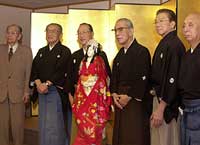|
|
|||||||
|
|
|||||||
|
|||||||
| | Web Japan >>| Trends in Japan >> | Arts & Entertainment >> | Puppet Masterpiece | |
|
PUPPET MASTERPIECE Bunraku Joins UNESCO's Intangible Heritage List (January 14, 2004) Ningyo Johruri Bunraku Puppet Theater, one of Japan's best-known classical art forms, was officially declared a Masterpiece of the Oral and Intangible Heritage of Humanity on November 11 by UNESCO (the United Nations Educational, Scientific and Cultural Organization). UNESCO instituted the list of intangible masterpieces in 2001 to complement its World Heritage program, which designates natural and cultural properties of special value to humanity. That first year, 19 forms of cultural expression were declared masterpieces, among them Japan's noh theater. Joining Japan's bunraku among the 28 masterpieces added in 2003 were the pansori epic chanting of Korea and the Royal Ballet of Cambodia.
A Team Effort During the Edo period (1603-1868), bunraku was a popular art beloved of the urban masses. In modern times, however, it was gradually superseded by cinema, European-style drama, popular music, and other Western forms of mass entertainment. In fact, in the period directly following World War II, it came perilously close to extinction, hanging on only with the help of government subsidies and a small coterie of enthusiasts. Recently, however, more and more Japanese, including many younger people, have been rediscovering bunraku's artistic appeal. Word that bunraku had been chosen by UNESCO's selection committee came right in the midst of this resurgence. Bunraku's most distinguished living puppet master, 84-year-old Yoshida Tamao, who has been designated a Living National Treasure, received the news of UNESCO's decision joyfully. "Whenever we've performed abroad the audience has been extremely enthusiastic," Yoshida remarks. "When we performed the Love Suicides at Sonezaki (Sonezaki shinju) in Paris a few years ago, the applause seemed to go on forever. People everywhere understand the emotions that bunraku expresses, and I think that people of any country can appreciate its artistic value as well." Inspired by UNESCO's proclamation, Yoshida plans to redouble his efforts to bring bunraku to the rest of the world.
Two Intangible Assets Chikamatsu's plays portray human emotion in a tragic but admirable light. Love Suicides at Sonezaki, for example, depicts the dilemma of star-crossed lovers who, faced with a choice between love and duty, choose to die together. During the first half of the eighteenth century, bunraku surpassed even kabuki in popularity, but in the nineteenth century it slipped into a decline from which it only began to recover about two decades ago.
A National Theater in Bunraku's Birthplace Nonetheless, the number of people directly involved in these performances is no more than about 90, including narrators, shamisen players, and puppeteers. Unlike kabuki actors, who inherit their craft and position from their fathers, bunraku performers need no pedigree, only skill. However, the acquisition of that skill is a lifetime undertaking. Novice puppeteers concentrate on the puppets' legs alone for about 10 years, after which they may progress to the left arm and hand. It is said to take at least 25 years to attain the status of omozukai, the main puppet master who controls the right arm and head. Fortunately, there is no shortage of young people eager to accept the challenge. And with bunraku taking its place among the acknowledged masterpieces of world culture, fans may rest assured that this enchanting art form will not be vanishing from Japan's cultural landscape any time soon. Related Web SitesNingyo Johruri Bunraku Puppet Theater in Japan Access Masterpiece of the Oral and Intangible Heritage of Humanity National Bunraku Theatre Copyright (c) 2004 Web Japan. Edited by Japan Echo Inc. based on domestic Japanese news sources. Articles presented here are offered for reference purposes and do not necessarily represent the policy or views of the Japanese Government. |
"CHUSHINGURA" (February 7, 2003) MASTER COMIC (February 1, 2000) |
|
|



